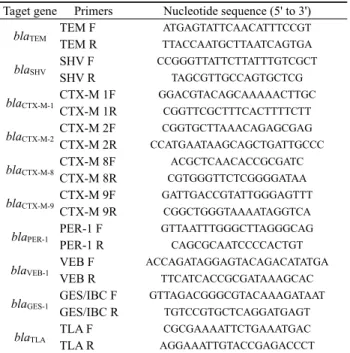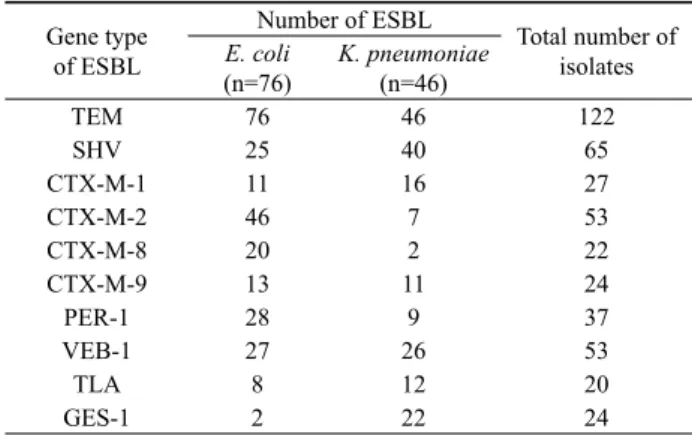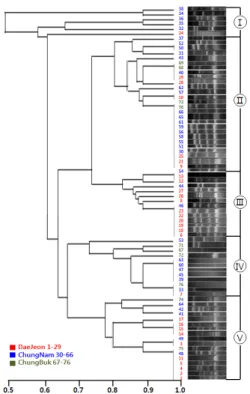Copyright ⓒ 2014, The Microbiological Society of Korea
충청지역병원에서 분리된 Extended-Spectrum β-Lactamase 생성 대장균과 폐렴간균의 bla 유전형 및 분자역학적 분석
육근돌1․양병선2․박진숙3*
1대전보건대학교 임상병리과, 2진주보건대학교 임상병리과, 3한남대학교 생명시스템과학과
bla Genotype and Molecular Epidemiological Analysis of Extended-Spectrum β-Lactamase-Producing Escherichia coli and
Klebsiella pneumoniae in Chungcheong Regional Hospitals
Keun Dol Yook1, Byoung Seon Yang2, and Jin Sook Park3*
1Department of Clinical Laboratory Science, Daejeon Health Science College, Daejeon 306-791, Republic of Korea
2Department of Medical Laboratory Science, Jinju Health College, Jinju 600-757, Republic of Korea
3Department of Biological Sciences and Biotechnology, Hannam University, Daejeon 305-811, Republic of Korea (Received May 21, 2014 / Accepted June 26, 2014)
A total of 122 ESBL-producing intestinal bacteria were collected from regional hospitals in the Chungcheong area.
Combination disk test (CDT) was performed for antimaicrobial susceptability using cefotaxime and cefotaxime/
clavulanate according to Clinical Laboratory Standard Institute (CLSI). Mutiplex PCR using specific primers was performed for a detection of ESBL-genotypes and enterobacterial repetitive intergenic consensus (ERIC)-PCR was carried out for the tracking of molecular epidemiology. In the confirmation test using CDT, 73 out of 76 (96.1%) ESBL-producing Escherichia coli and 43 out of 46 (93.4%) ESBL-producing Klebsiella pnemoniae were positive. In the multiplex PCR, 60.5% of E. coil were positive for CTX-M-2 type gene and 56.5% of K. pneumoniae were positive for VEB -1 type gene. In the ERIC-PCR, E. coil isolates formed 5 clusters and K. pneumoniae isolates were grouped into 4 clusters depending on region. Genotypes of clinical isolates are useful for detection and differentiation of ESBL producing intestinal bacteria. The ERIC-PCR method is thought to be helpful for establishing a regional surveillance system for infection due to its formation of different clusters depending on region.
Keywords: Escherichia coli, Klebsiella pnemoniae, CDT, ERIC-PCR, ESBL, multiplex PCR
*For correspondence. E-mail: jspark@hnu.kr; Tel.: +82-42-629-8771;
Fax: +82-42-629-8769
β-Lactam 항균제는 감염증 치료에 많이 사용되는 항생제이 나 근래 이러한 약제들이 임상에서 많이 사용되면서 이들의 남용 및 자연내성을 갖는 내성균의 증가가 문제로 대두되고 있다. 세균 이 β-lactam 항균제에 대한 내성을 획득하는 기전은 β-lactamase 생성, penicillin-binding protein의 변성, β-lactam 항균제의 세포막 투과성 저하, 세포 밖으로 항균제 유출 등 다양하며, 장내세균은 흔히 β-lactamase 생성에 의하여 β-lactam 항균제에 대한 내성을 획득한다(Edelstein et al., 2003). Extended-spectrum-β-lactamase (ESBL)는 주로 장내세균에서 생성되는데(Jacoby, 1991), 활성범위가 매우 넓어 carbapenem과 cephamycin을 제외한 β-lactam 항균제 대부분을 가수분해한다. 따라서 ESBL 생성균주는 penicillin과
제3세대 cephalosporin, monobactam 등 β-lactam계 항균제 대부분 에 내성을 보이며 aminoglycoside, trimethoprim sulfamethoxasole 등 여러 항균제에 내성을 보이는 경우가 많아 치료 약제를 선택하 기가 어렵다. 특히 병원성 균주들에서 ESBL 유전자는 plasmid에 의해 다른 균종으로 전파될 수 있기 때문에 이들에 대한 신속하고 정확한 검사가 중요하다(Hong et al., 2001; Lee et al., 2001;
Park et al., 2003). ESBL에는 여러 가지 유전형이 있으나 가장 흔 한 것으로 TEM과 SHV형이 있으며 2001년까지 TEM β-lactamase 에는 90가지 이상, SHV형은 25가지 이상이 보고되었다(Bradford, 2001). 우리나라에서는 1996년 E. coli와 K. pneumoniae 중에서 TEM과 SHV형 ESBL 생성균이 보고된 바 있다(Lee et al., 1996).
지금까지 밝혀진 ESBL 유전형은 150여 종 이상으로 TEM, SHV, CTX-M, PER, VEB 등 이외에도 여러 가지 유전형이 밝 혀져 있다(Bradford, 2001). 지금까지 ESBL 생성 장내세균의 검
Taget gene Primers Nucleotide sequence (5' to 3')
blaTEM TEM F ATGAGTATTCAACATTTCCGT
TEM R TTACCAATGCTTAATCAGTGA
blaSHV SHV F CCGGGTTATTCTTATTTGTCGCT
SHV R TAGCGTTGCCAGTGCTCG
blaCTX-M-1CTX-M 1F GGACGTACAGCAAAAACTTGC CTX-M 1R CGGTTCGCTTTCACTTTTCTT blaCTX-M-2CTX-M 2F CGGTGCTTAAACAGAGCGAG
CTX-M 2R CCATGAATAAGCAGCTGATTGCCC
blaCTX-M-8CTX-M 8F ACGCTCAACACCGCGATC
CTX-M 8R CGTGGGTTCTCGGGGATAA
blaCTX-M-9CTX-M 9F GATTGACCGTATTGGGAGTTT
CTX-M 9R CGGCTGGGTAAAATAGGTCA
blaPER-1 PER-1 F GTTAATTTGGGCTTAGGGCAG
PER-1 R CAGCGCAATCCCCACTGT
blaVEB-1 VEB F ACCAGATAGGAGTACAGACATATGA
VEB R TTCATCACCGCGATAAAGCAC
blaGES-1 GES/IBC F GTTAGACGGGCGTACAAAGATAAT GES/IBC R TGTCCGTGCTCAGGATGAGT
blaTLA TLA F CGCGAAAATTCTGAAATGAC
TLA R AGGAAATTGTACCGAGACCCT
Table 1. Oligonucleotides used as primers for amplification of ESBL genes
출에는 표현형적 특성을 이용하여 검출하는 방법이 널리 사용되 어 왔으나(Monica et al., 2004), 표현형적 방법은 검출에 시간이 많이 소요되며 접종량이 정확하지 않으면 정확한 결과를 얻기가 어려운 단점이 있다. 또한, ESBL 화학요법제에 대한 내성 유전 자의 정확한 동정은 병원에서의 원내감염의 감시와 역학적 연구 에 중요하다. Multiplex PCR을 이용한 ESBL 내성유전자의 검 출은 이에 유용한 것으로 알려져 있다. 분자역학조사의 표준화된 방법으로 Pulsed-field gel electrophoresis (PFGE) 분석법이 있 으나 이 방법은 수행하기에 기술적으로 어려움이 있으며, 시간소 모가 많고, 특수한 장비를 필요로 한다. PCR을 기초로 하는 다 른 typing 방법으로 randomly amplified polymorphic DNA (RAPD) 분석과 repetitive-element PCR (REP-PCR) 방법 등이 있다. REP-PCR 방법의 일종인 ERIC-PCR은 유전자 typing이 용이하며 신속한 유전자 검출이 가능하다. ESBL 생성 장내세균 의 typing에 있어, 감수성이 뛰어나며 재현성이 우수한 방법을 확립하여야만 한다(Silva et al., 2001). ESBL은 나라마다 종류 가 다양하게 보고되고 있으며 또한 그 나라의 지역 내에서도 효 소의 종류, 작용과 염기서열에 따른 점변이의 분포가 다르기 때 문에 많은 연구가 수행되고 있다(Jarlier et al., 1988; Pai, 1998;
Steward et al., 2001). 그러나 우리나라 충청지역에는 최근 연구 된 자료가 없어 이에 본 연구에서는 충청지역의 종합병원에서 분리된 장내세균 중 ESBL 생성균으로 추정되는 균의 항균제 감 수성을 조사하고, multiplex PCR을 수행하여 유전자형의 종류를 확인하고, ERIC-PCR을 이용하여 분자역학조사를 실시하였다.
재료 및 방법
균주 수집 및 실험 균주
2013년 6월 1일부터 2013년 12월 30일까지 충청지역(충남,
대전, 충북)의 종합병원 진단검사의학과 미생물 검사실에서 검 체를 수집하여, 임상검체로 부터 MicroScan WalkAway 96 SI (SIEMENS, Germany) 장비에 의해 ESBL 양성으로 추정되는 122균주를 분리하였다. 정도관리를 위하여 표준균주는 E. coli ATCC 25922를 이용하였다.
세균 동정 및 항균제 감수성 검사
검체를 MacConkey 배지에 접종하여 35℃ 항온기에서 하룻 밤 배양한 후, MicroScan Neg Breakpoint Combo Panel Type 44 (NBC44) 카드를 이용하여 세균동정 검사와 항균제 감수성 검사를 실시하였다.
Clinical and Laboratory Standards Institute (CLSI, 2011) 디스 크 확산법에 의하여 ESBL 생성 확인시험을 시행하였고, Mueller- Hinton 한천 배지에 McFarland 0.5 탁도의 균액을 바른 후 cefotaxime과 cefotaxime/clavulanate 디스크를 놓고 35℃에서 16-18시간 배양 후 억제대를 측정하여 억제대가 cefotaxime에 의 한 억제대보다 5 mm 이상 클 경우 ESBL 생성 양성 균주로 판정 하였다.
Multiplex PCR을 위한 primer 합성 및 유전자 증폭
β-lactamase의 유전형을 분석하기 위하여 primer는 Table 1 과 같이 제작하였다. Primer는 ESBL 유전자를 검출하기 위하여 PCR 산물에 의해 구별이 가능한 크기로 각 10쌍을 조합하여 사용 하였다. 다양한 ESBL 유전자를 동시에 검출하기 위하여 multiplex PCR을 수행하였다. 반응액은 0.5 µl 100 pmol forward primer 와 0.5 µl 100 pmol reverse primer, 5 µl 100 ng 주형 DNA, 5 µl 2 mM dNTP, 2-3 µl 25 mM MgCl2, 5 µl 10X reaction buffer, 0.5 µl 2.5 unit Taq DNA polymerase, 30.5–31.5 µl DW를 가하 여 최종부피 50 µl가 되도록 하여 PCR (Perkin-Elmer Centus Corp., USA)을 수행하였다. 반응조건으로는 95℃에서 5분간 반 응시킨 후, 94℃에서 1분, 50℃에서 1분, 72℃에서 1분씩 30회 증폭 반응시키고, 72℃에서 5분간 연장 반응시켰다.
각각의 PCR 산물은 1.5% agarose gel에서 40분간 전기영동 하였으며 전기영동 후 ethidium bromide (50 µl/ml)에 10분간 염색하여 DW로 세정 후 BioDoc-14TM Imaging system (UVP, UK)에 옮겨 PCR 증폭 산물의 유무와 크기를 관찰하고 사진 촬 영하였다.
ERIC-PCR
Enterobacterial repetitive intergenic consensus (ERIC) 부위 에 위치한 유전자를 대상으로 하는 forward primer 5′-AGTTAA GCTCCTGGGGATTCAC-3′과, reverse primer 5′-AAGTAAG TGACTGGGGTGAGCG-3′을 사용하였다. 반응액은 5 µl 10X PCR buffer, 5 µl 200 µM dNTP, 각 0.5 µl 200 nM oligonucleotide primer, 5 µl 2.5 U의 Taq polymerase 그리고 정제된 DNA 5 µl 100 ng을 혼합하고 DW를 가하여 최종부피 50 µl의 용액으로 하 였다. DNA thermal cycler (Perkin-Elmer Centus Corp.)를 이용 하여 94℃에서 1분, 42℃에서 1분, 65℃에서 8분간씩, 35 cycle 반응 후 최종적으로 10분간 연장반응 시켰다. ERIC-PCR 반응을
Strains CDT (%)
Positive Negative
E. coli (n=76) 73 (96.0%) 3 (4.0%)
K. pneumoniae (n=46) 43 (93.4%) 3 (7.6%) CDT, combination disk test
Table 2. Confirmation results of ESBL-producing E. coli and K.
pneumoniae by CDT
Gene type of ESBL
Number of ESBL
Total number of isolates E. coli
(n=76)
K. pneumoniae (n=46)
TEM 76 46 122
SHV 25 40 65
CTX-M-1 11 16 27
CTX-M-2 46 7 53
CTX-M-8 20 2 22
CTX-M-9 13 11 24
PER-1 28 9 37
VEB-1 27 26 53
TLA 8 12 20
GES-1 2 22 24
Table 3. Distribution of gene type of ESBL-producing E. coli and K.
pneumoniae
통해 증폭된 각각의 band size를 100 bp ladder와 비교 측정하였 으며, 생성된 band를 크기에 따라 정리하여 통계처리 program인 MVSP plus V2.0의 UPGMA 방법과 simple matching coefficient 에 의해 각 균주 간의 similarity matrix를 구성하고, plot program 을 이용하여 각 세균들 간의 dendrogram을 작성하였다.
결 과
항균제 감수성 검사
항균제 감수성 시험결과 MicroScan Walkaway 장비에서 ESBL 균 주로 추정된 E. coli 76균주 중에서 73균주(96.1%)가 cefotaxime 과 cefotaxime/clavulanate에서 양성으로 나타났으며 3균주는 음성 으로 나타났다. K. pneumoniae 46균주 중 43균주(93.4%)가 양 성으로 나타났으며, 3균주는 음성으로 판명되었다(Table 2).
Multiplex PCR
ESBL생성 E. coli 균주의 경우, CTX-M-2는 46균주, CTX-M-8은 20균주, PER-1은 28균주, 그리고 VEB-1은 27균주 에서 양성으로 검출되었으며 GES-1형은 2균주에서만 나타났 다. K. pneumoniae 경우 CTX-M-1은 16균주, CTX-M-2는 7균 주, CTX-M-8은 2균주, PER-1은 9균주, VEB-1은 26균주, GES-1은 22균주에서 양성으로 검출되었다(Table 3). 본 연구에 사용한 primer와 ESBL 생성 장내세균 균주에서는 TEM과 SHV 를 제외하고 CTX-M-2와 VEB-1이 가장 많은 유전자형이었다.
ERIC-PCR
ERIC-PCR을 실시하여 분자역학조사를 실시한 결과 충청지 역의 ESBL 생성 E. coli 균주들은 5개의 cluster를 형성하였다.
대전지역 균주들은 cluster 3과 cluster 5를 형성하였으며, 충남 지역에서 분리한 균주들은 cluster 1과 cluster 2를, 그리고 충북지 역에서 분리한 균주들은 cluster 4를 형성하였다(Fig. 1). K.
pneumoniae균주들의 경우 4개의 cluster를 형성하였으며 대전 지역에서 분리한 균주들은 cluster 1과 cluster 3을, 충남지역에 서 분리한 균주들은 cluster 3을, 그리고 충북지역에서 분리한 균 주들은 cluster 2와 cluster 4를 형성하였다(Fig. 2).
고 찰
최근에 β-lactam 항균제 내성세균에 의한 감염의 증가가 심각 한 문제로 대두되고 있다. 본 연구의 CDT 검사에서 E. coli 76균 주와 K. pneumoniae 46균주 중 각각 3균주는 음성으로 나타났 으나(Table 2), ESBL 유전형 분석 결과 CDT 음성균주 모두 양
성으로 나타났다. blaTEM에서 각각 100% 양성으로 검출되었다 (Table 3). CDT에 의한 항균제 감수성과 유전형의 불일치는 ESBL을 생성하는 균주의 경우 염색체성 AmpC β–lactamase의 생성량에 따라서 CDT 결과가 결정되기 때문인 것으로 알려져 있 다(Ruppe et al., 2006). 염색체성 AmpC β–lactamase의 생성량 이 낮으면 clavulanate에 의한 ESBL 활성 억제 효과가 발현되어 CDT 양성결과를 보이지만 반대로 AmpC β–lactamase 생성량이 많으면 CDT 음성결과를 보인다. 3균주가 CDT 음성으로 나타난 것은 AmpC β–lactamase 생성량이 많기 때문인 것으로 판단된다.
ESBL생성 장내세균에 대한 연구에서 Shin 등(2002)은 E.
coli의 9%가, Lee 등(2004)은 E. coli의 10.4%가 ESBL 생성균 인 것으로 보고하였다. Park 등(2003)은 2003년 보고한 연구에 서 E. coli의 10%에서 ESBL 생성균이 검출됨을 보고하였다. 질 병관리본부자료(2013)에 따르면 2011년 ESBL생성 E. coli는 27%, K. pneumoniae의 경우 45%로 보고하였다. 본 연구결과 충청지역에 국한되는 자료이나 2012년의 경우 E. coli는 31%로 나타나 증가하는 경향을 나타내었다. 반면 K. pneumoniae의 경 우 32%로 ESBL 생성균의 비율이 낮아진 것으로 나타났다.
ESBL 유전형을 분석한 결과 E. coli의 경우 76균주 중 46균주 에서 blaCTX-M-2가 검출되어 60.5%를 점하였으며 K. pneumoniae 의 경우 46균주 중 26균주에서 blaVEB-1이검출되어 56.5%를 점 하였다. blaTEM과 blaSHV를 제외하고 본 연구에 사용된 ESBL 122균주 중 총 53균주(43.4%)가 blaCTX-M-2와 blaVEB-1형으로 나 타나(Table 3) 가장 많은 유전형이었다. 분리된 122균주 중 122 균주(100%)가 blaTEM형 균주로, 65균주(53.2%)가 blaSHV형 균주 로 나타났으나 TEM과 SHV형인 경우 ESBL생성 균주임을 확 인하기 위해서는 염기서열 분석 등 보다 진전된 연구가 필요하다.
Poirel 등(1999)은 E. coli에서 VEB-1 (Vietnamese extended- spectrum β-lactamase) 유전자가 발현되며 cephalosporins과 aztreonam에 높은 수준에 내성을 보이는 것으로 보고하였는 바 본 연구에서도 총 122균주 중 43.4%에서 검출되어 우리나라에 서도 검출빈도가 높음을 알 수 있었다. blaCTX-M-8은 E. coli의 경우 26.3%, K. pneumoniae의 경우 4.3%에서 검출되었으며, blaGES-1
은 E. coli의 경우 2.6%에서만 검출된 반면 K. pneumoniae의 경 우 47.8%에서 검출되어(Table 3), 유전형의 분포에 있어 종간 차
Fig. 1. UPGMA cluster dendrogram of ESBL-producing E. coli based on ERIC-PCR.
Fig. 2. UPGMA cluster dendrogram of ESBL-producing K. pneumoniae based on ERIC-PCR.
이를 나타내었다.
임상검체에서 분리한 장내세균 균주의 분자역학조사 방법으 로 ERIC-PCR을 사용하였으며, 실험한 결과 ESBL 생성균주들 은 분리 지역에 따라 구분된 cluster를 형성하였다. E. coli는 분 리 지역에 따라 5개의 cluster를 형성하였으며, K. pneumoniae는 4 개의 cluster를 형성하였다(Figs. 1 and 2). 결론적으로 ERIC-PCR 에 기초한 분자유전학적 방법으로 ESBL 장내세균의 typing 분 류에 쉽게 접근할 수 있으며 빠른 결과를 얻을 수 있어 이들
ESBL 균주의 분자역학조사에 유용한 것으로 사료된다.
적 요
충청지역병원에서 ESBL생성 장내세균 122균주를 분리하여 Clinical and Laboratory Standards Institute (CLSI) 방법에 따라 cefotaxime과 cefotaxime/clavulanate를 이용한 combination disk test (CDT)에 의하여 항균제 감수성을 조사하고, 특이 유전 자를 대상으로 multiplex PCR을 실시하여 유전형을 검출하였으 며 enterobacterial repetitive intergenic consensus (ERIC)-PCR 에 의해 분자 역학조사를 실시하였다. ESBL 생성 Escherichia coli 76균주와 Klebsiella pneumoniae 46균주를 CDT로 확인한 결과, ESBL 생성 E. coli의 경우 96.1%가 양성을 나타내었으며 K. pneumoniae의 경우 93.4%가 양성을 나타냈다. Multiplex PCR 결과, E. coli의 경우 CTX-M-2형이 60.5% 양성으로 나타 났으며 K. pneumoniae의 경우 VEB-1형이 56.5%가 양성으로 나타났다. ERIC-PCR을 실시한 결과 E coli는 분리지역에 따라 5개의 cluster을 형성하였고 K. pneumoniae는 4개의 cluster을 형성하였다. ESBL생성 장내세균의 유전형은 임상에서 분리한 균주의 감별과 검출에 유용하였으며 ERIC-PCR의 결과는 분리 지역에 따라 cluster을 형성하여 지역 간 감염 감시체계 확립에 도움이 될 것으로 사료된다.
감사의 말
이 논문은 2014년 한남대학교 학술연구 조성비 지원에 의해 수행되었으며 이에 감사 드립니다.
References
Bradford, P.A. 2001. Extended-spectrum beta-lactamases in the 21st century: characterization, epidemiology, and detection of this important resistance threat. Clin. Microbiol. Rev. 14, 933‒951.
Clinical and Laboratory Standards Institute. 2011. Performance standards for antimicrobial susceptibility testing, Document M100-S21. CLSI. Wayne, Pensylvania, USA.
Edelstein, M., Pimkin, M., Palagin, I., Edelstein, I., and Stratchounski, L. 2003. Prevalence and molecular epidemiology of CTX-M extended-spectrum β-lactamase-producing Escherichia coli and Klebsiella pneumoniae in Russian hospitals. Antimicrob. Agents Chemother. 47, 3724‒3732.
Hong, S.G., Kang, M.S., Choi, J.R., Lee, K.W., Chong, Y.S., and Kwon, O.H. 2001. Molecular characteristics of extended-spectrum β -lactamases in clinical isolates of Enterobacteriaceae. Korean J.
Clin. Pathol. 21, 495‒504.
Jacoby, G.A. and Medeiros, A.A. 1991. More extended-spectrum β -latamases. Antimicrob. Agents Chemother. 35, 1697‒1704.
Jarlier, V., Nicolas, M.H., Fournier, G., and Philippon, A. 1988. Extended broadspectrum β-lactamases conferring transferable resistance to newer β-lactam agents in Enterobacteriaceae: hospital prevalence and susceptibility patterns. Rev. Infect. Dis. 10, 867‒878.
Korea Centers for Disease Prevention and Control. 2013. Monitoring of antimicrobial resistance on non-tertiary hospitals in Korea,
2007-2011, Annual report. 12‒21.
Lee, B.Y., Jeong, S.H., Jeong, T.S., Nam, H.J., Ji, J.H., and Hong, Y.R.
2001. Detection of extended-spectrum β-lactamase producing Escherichia coli and Klebsiella spp. with the Vitek GNS 121 card.
Korean J. Clin. Pathol. 21, 350‒354.
Lee, J.H., Bae, I.K., Kwon, S.B., Jeong, S.H., Woo, G.J., Lee, J.W., Lee, W.G., Kang, J.O., Ahn, J.Y., Hong, S.G., and et al. 2004. Prevalence of CTX-M-type extended-spectrum β-lactamase-producing Escherichia coli and Klebsiella pneumoniae isolates in Korea, 2003. Korean J.
Clin. Microbiol. 7, 111‒118.
Lee, K.W., Jo, S.R., Lee, C.S., Jung, Y.S., and Gwon, O.H. 1996.
Extended spectrum β-lactamase producing Escherichia coli and Klebsiella pneumoniae. Infection 26, 341‒348.
Monica, C., Sonia, M.T., Alejandro, P., Angeles, B.N., David, D., Francisca, V., Rosa, M., and German, V. 2004. Risk factors for colonization and infection in a hospital outbreak caused by a strain of Klebsiella pneumoniae with reduced susceptibility to expanded-spectrum cephalosporins. J. Clin. Microbiol. 42, 42‒49.
Pai, H.J. 1998. The characteristics of extended-spectrum β-lactamases in Korean isolates of Enterobacteriaceae. Yonsei Med. J. 39, 514‒
519.
Park, J.H., Lee, S.H., Jeong, S.H., Kim, B.N., Kim, K.B., Yoon, J.D., and Jeon, B.C. 2003. Characterization and prevalence of Escherichia coli and Klebsiella pneumoniae isolates producing an extended- spectrum β–lactamase from Korean hospitals. Korean J. Lab. Med.
23, 18‒24.
Poirel, L., Naas, T., Guibert, M., Chaibi, E.B., Labia, R., and Nordmann, P. 1999. Molecular and biochemical characterization of VEB, a novel class an extended-spectrum β-lactamase encoded by an Escherichia coli integron gene. Antimicrob. Agents Chemother. 43, 573‒581.
Ruppe, E., Bidet, P., Verdet, C., Arlet, G., and Bingen, E. 2006. First detection of the Ambler class C1 AmpC β-lactamases in Citrobacter frunddii by a new, simple double-disk synergy test. J. Clin.
Microbiol. 44, 4204‒4207.
Shin, K.S. and Son, B.R. 2002. Comparison of Vitek ESBL test and other methods for detecting extended-spectrum β–lactamase producing Escherichia coli and Klebsiella species. Korean J. Clin. Pathol. 22, 21‒26.
Silva, J., Gatica, R., Aguilar, C., Becerra, Z., Garza-Ramos, U., Velazquez, M., Miranda, G., Leanos, B., Solorzano, F., and Echaniz, G. 2001. Outbreak of infection with extended-spectrum beta-lactamase producing Klebsiella pneumoniae in a Mexican hospital. J. Clin.
Microbiol. 39, 3193‒3196.
Steward, C.D., Rasheed, K., Hubert, S.K., Biddle, J.W., Raney, P.M., Anderson, G.J., Williams, P.P., Brittain, K.L., Oliver, A., McGowan, J.E.
Jr., Tenover, F.C., and et al. 2001. Characterization of clinical isolates of Klebsiella pneumoniae from 19 laboratories using the National Committee for Clinical Laboratory Standards extended-spectrum β -lactamase detection methods. J. Clin. Microbiol. 39, 2864‒2872.


